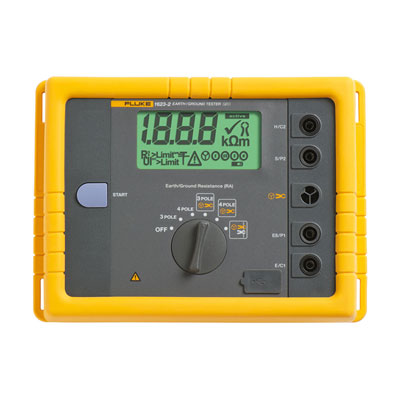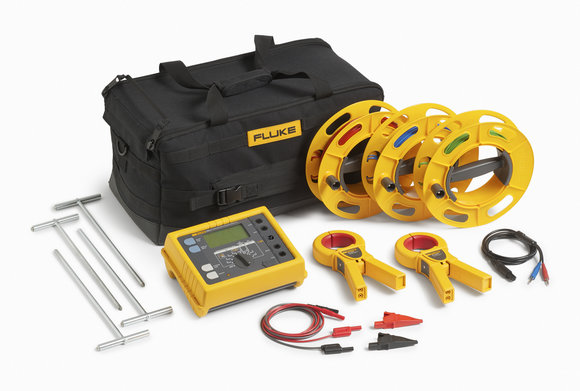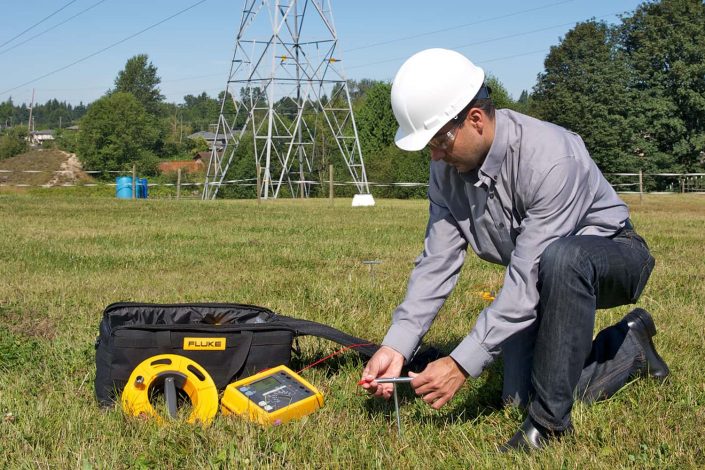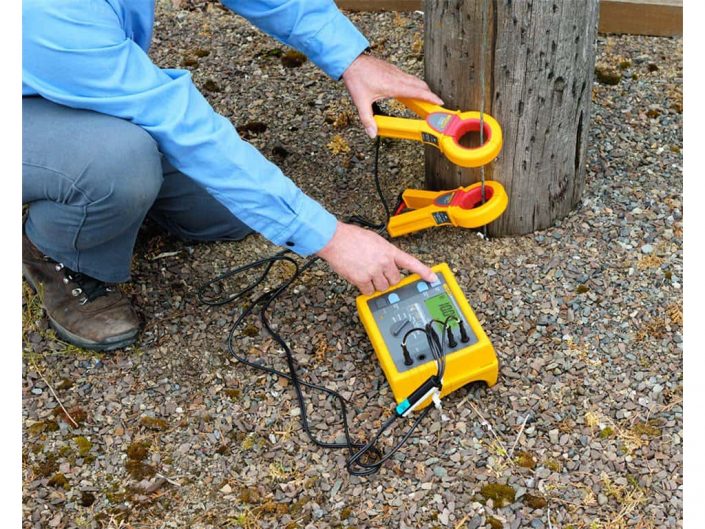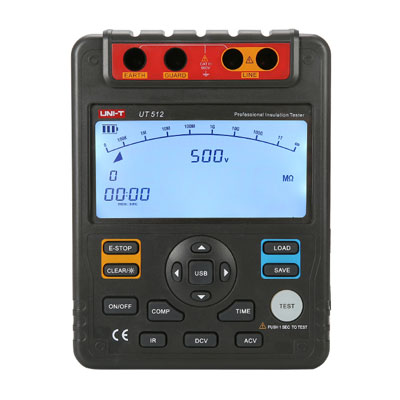FLUKE 1625-2 Kit Газардуулгын эсэргүүцэл хэмжигч
- үнэ: 21,500,000 төг
Key features
Stakeless Testing
The Fluke 1625-2 earth ground tester is able to measure earth ground loop resistances using only clamps. With this test method, two clamps are placed around the earth ground rod and each are connected to the tester. No earth ground stakes are used at all. A known, fixed voltage is induced by one clamp and the current is measured using the second clamp. Then the tester automatically determines the resistance of the earth ground rod. This test method only works if a bonded earth ground system exists for the building or structure under test, but most are. If there is only one path to ground, like at many residential applications, the Stakeless method will not provide an acceptable value and the Fall of Potential test method must be used.
With Stakeless testing, the earth ground rod does not need to be disconnected – leaving the bonded earth ground system intact during test. Gone are the days of spending time placing and connecting stakes for each earth ground rod on your system – a major time saver. You can also perform earth ground tests in places you’ve not considered before: inside buildings, power pylons, or anywhere you don’t have access to soil.
The Most Complete Tester
The Fluke 1625-2 is a unique earth ground tester that can performs all four types of earth ground measurement:
- – 3- and 4-Pole Fall-of-Potential (using stakes)
- – 4-Pole Soil Resistivity testing (using stakes)
- – Selective testing (using 1 clamp and stakes)
- – Stakeless testing (using 2 clamps only)
Product overview: Fluke 1625-2 GEO Earth Ground Tester Kit
The Fluke 1625-2 offers you simpler, faster earth ground tests than ever before. The 1625-2 offers internal memory storage up to 1500 records, accessible via USB port for rapid data transfer and viewing of results. This earth ground tester also gives you world-class accessories that take the tedium out of earth ground testing. New wire reels speed up setup and tear down time as much as 50%. Heavy duty stakes can be hammered into dry, hard soil. And new color-coded wires make setup simple and help eliminate mistakes.
The Fluke 1625-2 improves your earth ground testing process with:
- – Automatic Frequency Control (AFC) – identifies existing interference and chooses a measurement frequency to minimize its effect, providing more accurate earth ground value
- – R* measurement – calculates earth ground impedance at 55 Hz to more accurately reflect the earth ground resistance that a fault-to earth ground would see
- – Adjustable limits – for quicker testing
- – 3- and 4-pole Fall-of-Potential, earth resistance loop testing
- – 4-pole Soil Resistivity testing
- – Selective earth ground rod testing using 1 clamp
- – Stakeless earth ground rod testing using 2 clamps
- – IP56 rated for outdoor use
- – Rugged carrying case
Specifications: Fluke 1625-2 GEO Earth Ground Tester Kit
| General Specifications | |||||
| Memory | Internal memory storage up to 1500 records accessible via USB port | ||||
| Measuring function | Interference voltage and frequency, earthing resistance 3- and 4-pole with/without clip-on current transformer, resistance 2-pole with AC, 2- and 4-pole with DC | ||||
| Display | 4 digit (2999 Digit) – 7 segment liquid crystal display, with improved visibility | ||||
| Operation | Central rotary switch and function keys | ||||
| Temperature Range | |||||
| Operating temperature | -10°C to 50°C (14°F to 122°F) | ||||
| Storage temperature | -30°C to 60°C (-22°F to 140°F) | ||||
| Temperature coefficient | ±0.1% of reading/°C < 18°C > 28°C | ||||
| Type of protection | IP56 for case, IP40 for battery door according to EN60529 | ||||
| Max voltage | Warning – socket “clamp” to socket E, ES, S or H | ||||
| Urms = 0 V | |||||
| Sockets E, ES, S or H to each other in any combination, max. Urms = 250 V (pertains to misuse) | |||||
| Safety | Protection by double and/or reinforced insulation. Max. 50 V to earth per IEC61010-1. 300V CAT II, Pollution degree 2 | ||||
| Quality standard | Developed, designed and manufactured to comply with DIN ISO 9001 | ||||
| External field influence | Complies with DIN 43780 (8/76) | ||||
| Auxiliary power | 6 x 1.5 V alkaline (IEC LR6 or type AA) | ||||
| Battery life span | With IEC LR6/type AA: typ. 3,000 measurements (RE+RH ≤ 1 kΩ) | ||||
| With IEC LR6/type AA: typ. 6,000 measurements (RE + RH > 10 kΩ) | |||||
| Dimensions (W x H x D) | 250 x 133 x 187 mm (9.75 x 5.25 x 7.35 in) | ||||
| Weight | ≤ 1.1 kg (2.43 lb) without accessories 7.6 kg (16.8 lb) incl. accessories and batteries in carrying case | ||||
| Case material | Polyester | ||||
| Measurement of Interference Voltage DC + AC (UST) | |||||
| Measuring limits of error: method | Full wave rectification | ||||
| Measuring range | 1 V to 50 V | ||||
| Display range | 0.0 V to 50 V | ||||
| Resolution | 0.1 V | ||||
| Frequency range | DC/AC 45 Hz to 400 Hz sine | ||||
| Accuracy | ±(5% of rdg + 5 digit) | ||||
| Measuring sequence | Approx. 4 measurements/s | ||||
| Internal resistance | Approx. 1.5 MΩ | ||||
| Max. overload | Urms = 250 V | ||||
| Measurement of Interference Frequency (F) | |||||
| Measuring limits of error: method | Measurement of oscillation period of the interference voltage | ||||
| Measuring range | 6.0 Hz to 400 Hz | ||||
| Display range | 16.0 Hz to 299.9 Hz to 999 Hz | ||||
| Resolution | 0.1 Hz to 1 Hz | ||||
| Range | 1 V to 50 V | ||||
| Accuracy | ±(1% of rdg + 2 digit) | ||||
| Earthing Resistance (RE) | |||||
| Measuring method | Current and voltage measurement with probe as IEC61557-5 | ||||
| Open circuit voltage | 20/48 V, AC | ||||
| Short circuit current | 250 mA AC | ||||
| Measuring frequency | 94, 105, 111, 128 Hz selected manually or automatic. (AFC) 55 Hz in function R1 | ||||
| Noise rejection | 120 dB (16 2/3 , 50 , 60, 400 Hz) | ||||
| Max. overload | Urms = 250 V | ||||
| Electrical Measurement Specifications | |||||
| Intrinsic Error or Influence Quantity | Reference Conditions or Specified Operating Range | Designation Code | Requirements or Test in Accordance with the Relevant Parts of IEC 1557 | Type of Test | |
| Intrinsic error | Reference conditions | A | Part 5, 6.1 | R | |
| Position | Reference position ±90° | E1 | Part 1, 4.2 | R | |
| Supply voltage | At the limits stated by the manufacturer | E2 | Part 1, 4.2, 4.3 | R | |
| Temperature | 0°C and 35°C | E3 | Part 1, 4.2 | T | |
| Series interference voltage | See 4.2 and 4.3 | E4 | Part 5, 4.2, 4.3 | T | |
| Resistance of the probes and auxiliary earth electrodes | 0 to 100 x RA but ≤ 50 kΩ | E5 | Part 5, 4.3 | T | |
| System frequency | 99% to 101% of the nominal frequency | E7 | Part 5, 4.3 | T | |
| System voltage | 85% to 110% of the nominal voltage | E8 | Part 5, 4.3 | T | |
| Operating error | B = ±(|A| + 1,15 √E21 E22 E23 E24 E25E26 ) | Part 5, 4.3 | R | ||
| B[%] = ± B/fiducial value x 100%
A = intrinsic error |
|||||
| Measuring range | 0.020 Ω to 300 kΩ | ||||
| Display range | 0.001 Ω to 2.999 Ω | ||||
| 3.00 Ω to 29.99 Ω | |||||
| 30.0 Ω to 299.9 Ω | |||||
| 0.300 kΩ to 2.999 kΩ | |||||
| 3.00 kΩ to 29.99 kΩ | |||||
| 30.0 kΩ to 299.9 kΩ | |||||
| Resolution | 0.001 Ω | ||||
| 0.01 Ω | |||||
| 0.1 Ω | |||||
| 1 Ω | |||||
| 10 Ω | |||||
| 100 Ω | |||||
| Accuracy | ±(2% of rdg + 2 digit) | ||||
| Operating error | ±(5% of rdg + 5 digit) | ||||
| Measuring time | Typical 8 seconds with a fixed frequency 30 sec. max. with AFC and complete cycle of all measuring frequencies | ||||
| Additional error because of probe-and auxiliary earth electrode resistance | RH(RS + 2000 Ω)/RE x 1.25 x 10-6% + 5 digits | ||||
| Measuring error of RH and RS | Typ. 10% of RE + RS + RH | ||||
| Max. probe resistance | ≤ 1 MΩ | ||||
| Max. auxiliary earth electrode resistance | ≤ 1 MΩ | ||||
| Automatic check if error is kept within the limits required by IEC61557-5. If after a measurement of probe-, auxiliary earth electrode- and earthing resistance, a measurement error of higher than 30% is assumed because of the influencing conditions, the display shows a warning symbol and a notice that RS or RH are too high. |
|||||
| Automatic Switchover of Measuring Resolution in Dependence to Auxiliary Earth Electrode Resistance RH | |||||
| RH with Umeas = 48 V | < 300 Ω | ||||
| < 6 Ω | |||||
| < 60 Ω | |||||
| < 600 Ω | |||||
| RH with Umeas = 20 V | < 250 Ω | ||||
| < 2.5 kΩ | |||||
| < 25 kΩ | |||||
| < 250 kΩ | |||||
| Resolution | 1 mΩ | ||||
| 10 mΩ | |||||
| 100 mΩ | |||||
| 1 Ω | |||||
| Selective Measurement of the Earthing Resistance (RE Clamp) | |||||
| Measuring method | Current and voltage measurement with probe as per EN61557-5 and current measurement in the individual branch with additional current transformer (patent applied for). | ||||
| Open circuit voltage | 20/48 V AC | ||||
| Short circuit current | 250 mA AC | ||||
| Measuring frequency | 94, 105, 111, 128 Hz selected manually or automatically (AFC), 55 Hz (R1) | ||||
| Noise rejection | 120 dB (162/3, 50, 60, 400 Hz) | ||||
| Max. overload | Max. Urms = 250 V (measurement will not be started) | ||||
| Measuring range | 0.020 Ω to 300 kΩ | ||||
| Display range | 0.001 Ω to 2.999 Ω | ||||
| 3.00 Ω to 29.99 Ω | |||||
| 30.0 Ω to 299.9 Ω | |||||
| 0.300 kΩ to 2.999 kΩ | |||||
| 3.00 kΩ to 29.99 kΩ | |||||
| Resolution | 0.001 Ω | ||||
| 0.01 Ω | |||||
| 0.1 Ω | |||||
| 1 Ω | |||||
| 10 Ω | |||||
| Accuracy | ±(7% of rdg + 2 digit) | ||||
| Operating error | ±(10% of rdg + 5 digit) | ||||
| Additional error because of probe- and auxiliary earth typ. electrode resistance | RH(RS + 2000 Ω)/RETOTAL x 1.25 x 10-6% + 5 digits | ||||
| Measuring error of RH and RS | Typ. of 10% of RETOTAL + RS + RH | ||||
| Measuring time | Typ. 8 sec. with a fixed frequency 30 sec. max. with AFC and complete cycle of all measuring frequencies. | ||||
| Minimal current in single branch to be measured | 0.5 mA | With transformer (1000:1) | |||
| 0.1 mA | With transformer (200:1) | ||||
| Max. interference current through transformer | 3 A | With transformer (1000:1) | |||
| 1. With recommended current clamps/transformers. | |||||
| Resistance Measurement (R~) | |||||
| Measuring method | Current and voltage measurement | ||||
| Measuring voltage | 20 V AC, square pulse | ||||
| Short circuit current | > 250 mA AC | ||||
| Measuring frequency | 94, 105, 111, 128 Hz selected manually or automatically (AFC) | ||||
| Measuring range | 0.020 Ω to 300 kΩ | ||||
| Display range | 0.001 Ω to 2.999 Ω | ||||
| 3.00 Ω to 29.99 Ω | |||||
| 30.0 Ω to 299.9 Ω | |||||
| 300 Ω to 2999 Ω | |||||
| 3.00 kΩ to 29.99 kΩ | |||||
| 30.0 kΩ to 299.9 kΩ | |||||
| Resolution | 0.001 Ω | ||||
| 0.01 Ω | |||||
| 0.1 Ω | |||||
| 1 Ω | |||||
| 10 Ω | |||||
| 100 Ω | |||||
| Accuracy | ±(2% of rdg + 2 digit) | ||||
| Operating error | ±(5% of rdg + 5 digit) | ||||
| Measuring time | Typical 6 seconds | ||||
| Max. interference voltage | 24 V, with higher voltages measurement will not be started | ||||
| Max overload | Urms max. = 250 V | ||||
| Resistance Measurement (R DC) | |||||
| Measuring method | Current- voltage measurement as per IEC61557-4 possible | ||||
| Measuring voltage | 20 V DC | ||||
| Short circuit current | 250 mA DC | ||||
| Formation of measured value | With 4-pole measurement wires on H, S, ES can be extended without additional error. Resistances > 1 Ω in wire E can cause additional error of 5m Ω/Ω. |
||||
| Measuring range | 0.020 Ω to 300 kΩ | ||||
| Display range | 0.001 Ω to 2.999 Ω | ||||
| 3.00 Ω to 29.99 Ω | |||||
| 30.0 Ω to 299.9 Ω | |||||
| 300 Ω to 2999 Ω | |||||
| 3.0 kΩ to 29.99 kΩ | |||||
| 30.0 kΩ to 299.9 kΩ | |||||
| Resolution | 0.001 Ω | ||||
| 0.01 Ω | |||||
| 0.1 Ω | |||||
| 1 Ω | |||||
| 10 Ω | |||||
| 100 Ω | |||||
| Accuracy | ±(2% of rdg + 2 digit) | ||||
| Operating error | ±(5% of rdg + 5 digit) | ||||
| Measuring sequence | Approx. 2 measurements/s | ||||
| Measuring time | Typical 4 second including reversal of polarity (2-pole or 4-pole) | ||||
| Maximum interference voltage | ≤ 3 V AC or DC, with higher voltages measurement will not be started | ||||
| Maximum inductivity | 2 Henry | ||||
| Maximum overload | Urms = 250 V | ||||
| Compensation of Lead Resistance (RK) | |||||
| Compensation of lead resistance (RK) can be switched on in functions RE 3-pole, RE 4-pole (clamp), R AC, and R DC 2-pole | |||||
| Formation of measured value | Rdisplay = Rmeasured – Rcompensated2 | ||||
| 2. Value of setpoint entry RK = 0.000 Ω, variable from 0.000 to 29.99 Ω by means of measuring adjustment. | |||||
| Stakeless Ground Loop Measurement (Two Clamp Stakeless) | |||||
| Switch position | RA 4-pole (two clamp Stakeless) | ||||
| Resolution | 0.001 Ω to 0.1 Ω | ||||
| Measuring range | 0.02 Ω to 199.9 Ω | ||||
| Accuracy | ±(7% rdg + 3 digit) | ||||
| Operating error | ±(10% rdg + 5 digit) | ||||
| Measuring voltage | Vm = 48 V AC (primary) | ||||
| Measuring frequency | 128 Hz | ||||
| Noise current (IEXT) | Max. IEXT = 10 A (AC) (RA < 20 Ω) | ||||
| Max. IEXT = 2 A (AC) (RA > 20 Ω) | |||||
| Measuring principle: Stakeless measurement of resistance in closed loops using two current transformers. Automatic range selection. The information regarding stakeless ground loop measurements is only valid when used in conjunction with the recommended current clamps at the minimum distance specified. |
|||||
Санал болгох бараа
Үйлдвэрлэгч
Хэмжих хэрэгсэл
 Мультиметр
Мультиметр Амперклещ
Амперклещ Эсэргүүцэл хэмжигч
Эсэргүүцэл хэмжигч- LCR метр
 Осциллограф
Осциллограф- Спектр анализатор
 Дохионы үүсгүүр
Дохионы үүсгүүр Тэжээлийн блок
Тэжээлийн блок- Цахилгаан хэмжигч, хайгч
 Термометр
Термометр- Орчны тестер
 Сүлжээний тестер
Сүлжээний тестер- Тахометр
- Зай хэмжигч
- Бусад хэмжих хэрэгсэл
- Дагалдах хэрэгсэл
Гагнуурын хэрэгсэл
 Нихром гагнуурын алх
Нихром гагнуурын алх Керамик гагнуурын алх
Керамик гагнуурын алх- Тохируулгатай гагнуурын алх
- Үлээдэг гагнуурын алх
- Урьдчилан халаагч
- Утасгүй гагнуурын алх
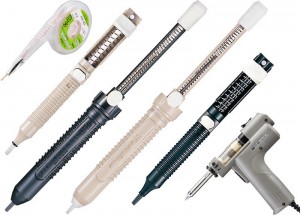 Тугалга сорогч
Тугалга сорогч- Тугалга, давирхай
- Эд анги
- Хошуу
- Халаагч
- Гар
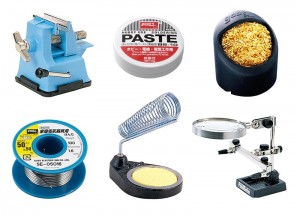 Туслах хэрэгсэл
Туслах хэрэгсэл- Халуун цавууны буу
- Хамгаалалтын хэрэгсэл
Гар багаж
- Халив
- Нарийн халив
- Том халив
- Тусгай халив
- Цахилгаан халив
- Халив цуглуулга
- Тусгай түлхүүр, торцов
- Бахь
- Бахь
- Нугас, махир хошуут бахь
- Таслагч бахь
- Хямсаа
- Кабел үзүүрлэгч
- Төгсгөвч хавчигч
- Сүлжээний бахь
- Цагираг түгжээ авагч
- Хайч, хутга
- Өрөм, хөрөө, хуурай
- 1000В гар багаж
- Туслах хэрэгсэл
Томруулдаг шил
- Микроскоп
- Томруулдаг шил
- Суурин томруулдаг шил
Багажны цуглуулга
- Электроникийн багаж
- Цахилгааны багаж
- Сүлжээний багаж
- Багажны цүнх
Лавлах утас: 77107805, 99198321
Хаяг : Улаанбаатар хот, Чингэлтэй дүүрэг, Компьютер ланд, 3-н давхар, 12 тоот
“ЧИП ЭЛЕКТРОНИКС” ХХК
© Copyright – 2025 www.chip.mn

